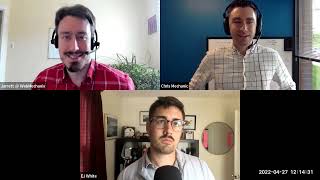
Here’s This Week’s Virtual Roundtable with Top Chief Marketing Officers
Chris Mechanic, co-founder of WebMechanix, brought together a fresh cohort of chief marketing officers for a virtual discussion, spurred by the success of the first two events. The meeting aims to share insights, challenges, and innovative breakthroughs related to COVID-19. This week’s discussion developed around the theme of how to best leverage a positive tailwind caused by COVID. Here are the highlights.
CMO of a a cybersecurity vendor that primarily combats phishing
COVID-19 has brought a substantial increase in phishing attempts and other scams. For this company, this has meant more business and the opportunity to inform and protect the public as a thought leader. Right now, they’re focusing on paying it forward by doing good work and sharing research. Their latest webinar on COVID-19 phishing threats had 1,300 attendees, the largest they’ve seen to date. They’re trying to generate enough leads to offset their losses from the lack of in-person events.
CMO of a software, data, and media company
This company offers products and services that fit the current market. With the uncertainty around COVID-19, many people want to know what’s happening with policies and are looking to stay on top of the latest news.
They have seen similar trends with its webinars, each getting 800 to 900 attendees. People are craving information, so their team is giving it to them through free, local coverage.
Additionally, the business is helping nonprofits move their big in-person conferences online since few of them have operated virtually in the past. In terms of finances, the company is reallocating its resources rather than cutting or increasing its budget.
CMO of an e-commerce retailer logistics provider
This company provides an Amazon-level experience to brands that don’t want to give everything to Amazon. There’s been a spike in demand for their solution since Amazon switched to shipping only essentials. Even so, it has seen increased demand for non-essentials, especially for beauty products.
Casey credits his CEO for the company’s momentum. They have fulfillment centers all over the country, and the employees at these centers can’t work from home. The CEO called them to arms and prepared the team for the worst-case scenario. It obtained protective measures and equipment at these centers much earlier than most other companies, allowing its employees to continue working on site without compromising their health.
As far as thought leadership goes, the company has published its industry vertical data across all of its available networks, and that’s gotten picked up and has driven a lot of attention.
They also modeled their software after Amazon to prioritize essential products first. Since it isn’t as large as Amazon, it’s able to get all of its products shipped. Companies are realizing that Amazon owns their entire business, so they’re looking for other options—and that spells more business.
The company’s sales cycles have accelerated. Whereas before it was typically 90 to 100 days, they’re now seeing deals close in 10 to 14 days. They’re helping keep thousands of businesses running and are fortunate enough to be in a good position.
CMO of a B2C financial services company that helps people with debt
This business’s market is getting bigger—in fact, it’s booming. With that, he sees two challenges: one with clients and another with new prospects. It makes its revenue over time with an annuity model. If clients have economic setbacks, they may stop using the company’s services. They have been taking an active approach to reach out to clients and make sure they stay on top of what they’re doing. They’ve also been providing helpful resources and messages of hope, letting people know that everyone is going through this pandemic and that we’ll all get through it.
On the prospect side, the business has certainly seen more inquiries due to COVID-19. While the company’s best campaigns were historically predictable in terms of what keyword or message reeled in a prospect, their current campaigns aren’t performing as they used to. Their current theory is that there are a lot more prospects that are tire-kicking or frozen from making a decision because of an uncertain future. With that in mind, they’re offering a step-up program that lets people get started and gives them the option to spend more aggressively over time if they’d like to, essentially shifting its messaging from “buy now” to a more hopeful outlook.
As a result of this change in messaging, he has found that more prospects are calling and responding. The company is using this time to build relationships with prospects instead of focusing on improving their conversion rate. Joe’s advice is to figure out who is in your marketing database and identify creative ways to speak to them differently.
Unfortunately, he isn’t as prepared as it should be with content creation in light of COVID-19. For one, they haven’t done any webinars. They also have a lot of fires to put out, but they’re trying to take the first step by at least creating some videos.
CMO of a managed IT services provider
This business blew up with COVID-19, and its services are now more in demand. It has 1,500 companies as customers, with a total of 70,000 employees, so it went from supporting 2,000 locations to 70,000 locations.
Their customers assumed they could transition to working from home easily, but this turned out to be more challenging than they anticipated. The customer support team has been swamped with phone calls and has had to put out a lot of fires.
She is one of only two people on her team. And their main priority is retaining clients. They pivoted early and put a hold on active marketing campaigns.
Since the business had the right SEO and content in place, its web traffic doubled in March, and that trend has continued through April. They’re also getting more leads than before and haven’t seen a drop in conversion rates to customers. Leads, however, are closing faster than before.
As of now, their concern is how June and July will look since most of its current activity is from existing customers. Some clients won’t make it through this period, so the company’s trying to create campaigns to get new customers. They’re also trying to figure out the best course of action in general, just like everyone else.
CMO of an international risk management company
Their insurance reimburses businesses for when people can’t pay for their 30- or 60-day accounts receivable. They also provide a tool that makes it easier for customers to find the best people to do business with.
As you can imagine, more people are interested in their product than before. They are seeing an increase in marketing qualified leads (MQLs). Their typical sales cycle is 90 to 120 days, so they’ll still have to wait and see if that decreases.
The product innovation and sales enablement team want to make sure that the company don’t appear like it’s capitalizing on misfortune. They want to show ways that they can help people during these trying times.
The company has a new platform that’s ready for beta testing. They saw an opportunity to help out and promote that product, so they’ll give it away for free for the next two to three months, which is a popular marketing play these days.
They did a large webinar campaign a while ago, so now that webinars are all that people can do, it’s worked out well. The team plans to create content for people who are scrambling for answers on what may happen in the near future.
Chris Mechanic
People are bored and crave social interaction, so they’re attending more webinars. There’s more attention online right now, and it’s an excellent opportunity for B2C and B2B.
Some industries are doing well. WebMechanix has a fitness equipment client that went from 4 to 12 ROAS because of COVID-19. They’ve sold out of their inventory until May because people can’t go to gyms, so they need home equipment.
This economic contraction is unique from any other that we’ve experienced so far since businesses are collecting more prospects and CPMs are down, but depending on the industry, fewer prospects are converting into customers.
With that being the case, Chris suggests adjusting your remarketing list length from the default of 30 days to longer since prospects will need more time to buy as they plan more carefully for the future.
Group Discussion
One CMO had put a plan to do customer research on the back burner prior to COVID-19, but now he’s thinking this may be a good time to do that since most people are at home.
Another mentioned that she conducted a pulse survey with 50 senior executives on their thoughts regarding COVID-19. She saw lower engagement than usual, but overall, it’s been well received.
Chris chimed in, noting that now is a phenomenal time for customer retention and sharing useful content. That’s why he’s doing these round table discussions: so he can learn about different strategies that other marketers are trying and to share those insights with clients.
In terms of learning more about one’s audience, someone mentioned that he added questions in his prospect inquiry process to reveal whether or not prospects are ready to buy. While his market is getting larger, it’s also getting messier. The more you can define your prospect segments, the better you’ll be able to make use of the resources and messaging at your disposal.
Someone asked the group if anyone else feels like their entire strategy shifted, almost like they’re starting from scratch. One CMO feels so on the event side. They decided to pull back from conferences and trade shows even before COVID since the ROI was always questionable and they’re usually expensive. It just so happened that their shift to virtual events worked out well. They have a lot of money earmarked for trade shows that will now be reallocated elsewhere. Costs are almost nothing, but the labor of managing virtual events will be a new expense to account for.
Someone replied and said she doesn’t feel like she’s starting from scratch. She does feel like she had to temporarily pivot and now has to do more thought leadership and strong “pull” marketing.
Another CMO had a similar situation with in-person events, though events are more important in his industry since they offer a conversational setting to educate people about his product. The content marketing that his team did over the past two years has paid off.
We plan to hold more virtual round tables, so keep checking our blog to learn the latest tips and strategies for marketing during COVID-19.
Most newsletters suck...
So while we technically have to call this a daily newsletter so people know what it is, it's anything but.
You won't find any 'industry standards' or 'guru best practices' here - only the real stuff that actually moves the needle.






